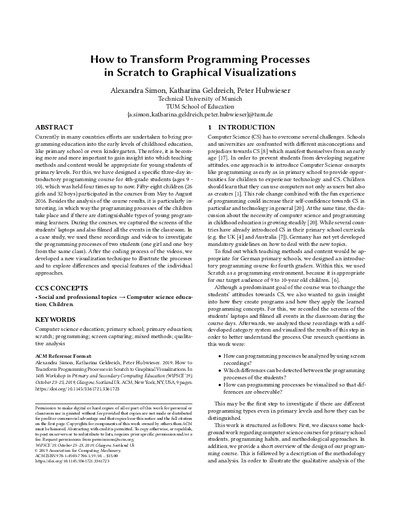How to Transform Programming Processes in Scratch to Graphical Visualizations Publikationsdatum:
|
 |
 Diese Seite wurde seit 2 Jahren inhaltlich nicht mehr aktualisiert.
Unter Umständen ist sie nicht mehr aktuell.
Diese Seite wurde seit 2 Jahren inhaltlich nicht mehr aktualisiert.
Unter Umständen ist sie nicht mehr aktuell.
 Zusammenfassungen
Zusammenfassungen


Currently in many countries efforts are undertaken to bring programming education into the early levels of childhood education, like primary school or even kindergarten. Therefore, it is becoming more and more important to gain insight into which teaching methods and content would be appropriate for young students of primary levels. For this, we have designed a specific three-day introductory programming course for 4th-grade students (ages 9-10), which was held four times up to now. Fifty-eight children (26 girls and 32 boys) participated in the courses from May to August 2016. Besides the analysis of the course results, it is particularly interesting, in which way the programming processes of the children take place and if there are distinguishable types of young programming learners. During the courses, we captured the screens of the students' laptops and also filmed all the events in the classroom. In a case study, we used these recordings and videos to investigate the programming processes of two students (one girl and one boy from the same class). After the coding process of the videos, we developed a new visualization technique to illustrate the processes and to explore differences and special features of the individual approaches.
 Dieses Konferenz-Paper erwähnt ...
Dieses Konferenz-Paper erwähnt ...
 Dieses Konferenz-Paper erwähnt vermutlich nicht ...
Dieses Konferenz-Paper erwähnt vermutlich nicht ... 
 Nicht erwähnte Begriffe | Eltern, Fehlvorstellungen beim Programmieren, Fehlvorstellungen bezüglich Variablen, Informatik-Didaktik, Informatikunterricht in der Schule, Schule |
 Tagcloud
Tagcloud
 Zitationsgraph
Zitationsgraph
 Zitationsgraph (Beta-Test mit vis.js)
Zitationsgraph (Beta-Test mit vis.js)
 1 Erwähnungen
1 Erwähnungen 
- Programmieren in der Grundschule - Eine Design-Based-Research-Studie (Katharina Geldreich) (2023)


 Anderswo finden
Anderswo finden
 Volltext dieses Dokuments
Volltext dieses Dokuments
 |  How to Transform Programming Processes in Scratch to Graphical Visualizations: Artikel als Volltext ( How to Transform Programming Processes in Scratch to Graphical Visualizations: Artikel als Volltext ( : :  , 10205 kByte; , 10205 kByte;  : :  ) ) |
 Anderswo suchen
Anderswo suchen 
 Beat und dieses Konferenz-Paper
Beat und dieses Konferenz-Paper
Beat hat Dieses Konferenz-Paper während seiner Zeit am Institut für Medien und Schule (IMS) ins Biblionetz aufgenommen. Beat besitzt kein physisches, aber ein digitales Exemplar. Eine digitale Version ist auf dem Internet verfügbar (s.o.). Es gibt bisher nur wenige Objekte im Biblionetz, die dieses Werk zitieren.









 Kinder
Kinder Kindergarten
Kindergarten Primarschule (1-6) / Grundschule (1-4)
Primarschule (1-6) / Grundschule (1-4) Programmieren
Programmieren Scratch
Scratch Visualisierung
Visualisierung




 Biblionetz-History
Biblionetz-History